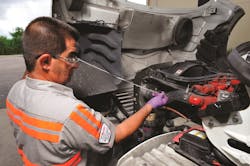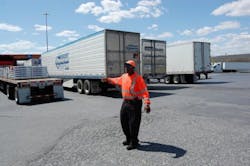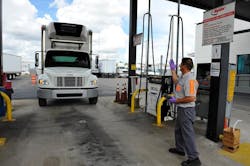Kelly Rhinehart, as co-owner and founder of Roady’s, spends time every day pondering where the trucking industry and his truck stops are headed, both in the near future and for the next generation. That encompasses everything from reconsidering restaurant layouts, to changes in freight delivery patterns, to how to handle trucks that run on electricity, and the potential impact of driverless trucks.
But while devoting some time to plan 10 or 20 years ahead will certainly pay off for those who get it right, truck stop operators first have to tend to today and the next quarter. Surprisingly, in these digital and connected days with new apps for everything, the trend in truck stops is decidedly retro.
A personal touch, it seems, is more important than technology when it comes to keeping truck drivers happy—although technology certainly plays an important role.
“We’re purposefully trying to be what drivers used to like about truck stops. And what they like is old school truck stops,” Rhinehart says. “They like the independence of being in Louisiana and having a ‘gator burger,’ but they also like to go up to Seattle and have the local coffee cake. They’re stopping in truck stops 2.1 times a day, and if it’s the same thing over and over, life gets pretty tedious.”
So for Roady’s locations, about 350 from coast to coast, managers feature the same 88% of offerings as the other stores, but they’re also directed to make that remaining 12% uniquely their own—“what sets you apart.”
“There is no opportunity to be less than world class in service,” he says. “That’s an absolute must.”
And that refocus on the customer is one of the positives that came out of the recession and trucking downturn from 2008-2010.
“We’re embracing the truck stop. 'Travel centers,' 'travel plazas,' that was all a hot button for several years. What we do recognize today is truck drivers are way more professional. That’s not their carriage or demeanor, but what’s expected by their employers is way different than it used to be,” Rhinehart explains. “Their time demands keep getting increased with all of the administrative things they have to stay on top of. They have computers on board and electronic logs.
“They don’t have to come into the truck stops to use the phones or rent a computer or even to use WiFi,” he continues. “There are lots of different opportunities for them to be connected with their families, their banks, everything. So we need to meet them where we are.”
Rhinehart tells of a restaurant remodel whose business went down with the upgrade. Turns out, removing counter seats and adding booths wasn’t what truck drivers wanted.
“It makes you a better driver when you’re talking to a buddy, finding out what he’s doing and telling him what you’re doing,” he continues. “It makes the industry stronger, and those relationships can last.”
Roady’s routinely does parking lot surveys, and they’ve found that a lot of drivers never set foot inside the stores.
“They get their fuel and they go to the parking lot. But we want those guys,” Rhinehart says. “How can we meet their needs?”
As a result, Roady’s has put employees in the parking lots trying everything from cleaning headlights to delivering a soda and a candy bar.
Reaching out
And that’s exactly the strategy adopted by North America’s largest truck stop chain.
“Driver service champions,” or DSCs, are now out on the fuel islands and in the parking lots at 125 Pilot Flying J locations, reports Ken Parent, chief operating officer at Pilot Flying J. DSCs help direct traffic, solve problems with fuel transactions, and make sure the driver feels welcomed—and that his time is not being wasted.
From a facilities perspective, Pilot Flying J’s new concept focuses on presenting a clean, updated look and safe, comfortable feel. The PJ Fresh Marketplace, likewise, explores healthy choices in driver food options.
Technological innovations also are about providing choices to drivers, helping them get in and out quickly to be more productive in their workday—“whether they want face-to-face interaction, or to utilize the kiosk to print a receipt or reserve a shower.”
Similarly, the chain is rolling out a mobile point-of-sale device, a “line buster,” that will allow a roving store clerk to just swipe a customer’s card to complete a transaction. They’re also expanding an “assisted checkout” program to provide a fast and easy self-service option.Behind the scenes, Pilot Flying J has invested in technology to greatly reduce the amount of time employees spend resolving transactions, freeing them up to spend time assisting customers, Parent notes.
“We’re not taking the benefits of the technology to decrease our labor,” Parent says. “We’re actually increasing our customer service representatives.”
Indeed, this focus on the “personal touch” is becoming something of a “competitive differentiator” among the 2,500 or so truck stops across the United States.
Darren Schulte, vice president of membership for NATSO (formerly known as the National Assn. of Truck Stop Operators), explains that his organization recently did a “snap survey” of 100 or so truck drivers at a NATSO-member location. The operator thought the main selling point of his location revolved around maintaining low fuel prices.
Not so, notes Schulte. “The number one reason the drivers we surveyed said they selected this gentleman’s location? The friendliness of the staff,” he says. “Low fuel prices actually ranked third, with the quality of food in second place.”
Schulte also suggests that NATSO’s research indicates that the “fundamentals” make a huge difference in the truck stop industry today, with the personal touch packaged together with clean showers, clean facilities overall, and more focus on specific customer attributes.
“It’s really critical to understand the specific customers using your particular location,” he says. “Are they owner-operators or company drivers? Do you get a lot of pet owners?”
Schulte also notes that the truck stop industry is returning to its roots in a way by splitting into two distinct camps: the full-service facility and the fuel-and-go location.
“Historically, everyone tried to provide everything—washers and drivers, truck washes, repair shops, etc.,” he points out. “Today, though, with the hours-of-service rule changes made several years ago, time is money. So now drivers and fleets stop based on whether they need just fuel and food or if a longer stop for maintenance or overnight parking is needed.”
Yet even the short-term “fuel-and-go” locations are deploying the personal touch, Schulte adds.
“One of our members developed a ‘food while you fuel’ option so [drivers] could place an order while refueling their truck. Then it gets brought out to them by a ‘truck hop’ server,” he explains. “It’s a way to make that stop, however short in duration, a more friendly experience. And making it more personal may convince that driver and/or fleet to use that truck stop again down the road.”
Check your tires for you, driver?
Speaking of returning to roots, many drivers today might be too young to remember when fuel pumps came with attendants dedicated to quick and convenient vehicle service. Those days are coming back for truckers.
Indeed, about three years ago, a Love’s focus group suggested that tire care was a critical issue, and fleets and operators needed help making sure tires were properly inflated and the tread was up to spec. The tricky part, of course, was that drivers couldn’t be stuck sitting around while the tires were being rechecked.
The result is the TirePass program. Based on a technology that assesses tire pressure and tread depth with a handheld device, TirePass works from a dedicated fuel island at Love’s locations.
When a truck arrives to fuel, an attendant connects all of the tires on the tractor and trailer to a tire inflation system on the island. The handheld device then communicates with the inflator, which fills the tires to the proper pressures. As the attendant removes the hoses, he checks the tread.
The software behind TirePass allows customers to set the tire specs for a vehicle or a fleet, so when a truck pulls up and its QR code is scanned, the inflation system is set accordingly.
TirePass is installed and expected to be operational at 90 locations by the end of summer in the first phase. Love’s is also exploring other services that might be offered at the island, although Jensen declined to reveal more details.
Going forward, new Love’s locations will be built with the TirePass lane, and current locations eventually will be retrofit with the system.
“These trucks are on the road all the time, and some of them—especially the trailers—don’t get back to the yards very often. So being able to keep [tabs on] casings, to track a tire through its entire life, has always been very tough,” Jensen says. “This idea was to ‘let us help you manage the tire from cradle to grave.’ The drivers appreciate it because it’s a hard, tedious job to check the tires every day. We can help make that easier for them.”
Check your oil, too?
Ryder doesn’t operate a national truck stop chain, but the leasing company does have more than 400 fueling locations around the country to service Ryder lease, rental and contract maintenance customers.
Ryder is rolling out a new handheld computer system to streamline the fuel transaction process. The units are capable of reading RFID and scanning barcodes. The device captures the vehicle ID and odometer reading, among other data, and relays it to the reporting system, explains Scott Perry, Ryder’s vice president of supply management and global fuel products.
“What’s unique about our model is we’re one of the few remaining full-service fueling networks,” Perry says. “We have company employees who are actually manning our service islands, interacting with our customers’ drivers, validating information around the vehicle being fueled, and then actively fueling the vehicle while they’re also performing other safety and maintenance checks as a walk-around inspection. We find that definitely leads to a higher level of checks and balances around the transaction.”
Ryder’s been doing it this way for 83 years, he adds, and still sees it as an important service. The inspection points—whether engine fluids or trailer lights—all contribute to customer uptime.And while it’s admittedly “old school,” the complex technology that comes with modern trucks demands more expertise than was required of a corner service station attendant a generation or two ago.
“They definitely play a role in helping to support the proper use of diesel exhaust fluid, for instance, and they often get asked about lights that may come up on the dash. They definitely get asked a lot of questions about the performance of the vehicles, and they play a role in our environment of creating a write-up or a service order if they find something out of compliance,” Perry says. “They really are the eyes and the ears for interacting with the drivers, the intermediary between the driver and the shop to expedite the engagement and make sure we get that truck back on the road as quickly as possible.”
And these interactions get back to the customer through the Ryder web portal. Likewise, fuel reporting is configured according to the fleet’s needs.
“As the technology continues to evolve around dispenser systems and the use of RFID, and how you’re validating the transaction, we continue to look at how that can be integrated to help make that as automated and concise and clean as is possible,” he concludes.
Data, data everywhere
Integrating vehicle telematics, routing, and fleet management systems with truck stop data—whether customer loyalty information, fueling details, or maintenance—is an obvious opportunity.
But an area where truck stop operators are especially interested in helping themselves and, more importantly, the trucking industry overall, is providing information on the availability of parking spaces.
Indeed, technology already exists that can track parking spaces, keeping up with how many spots are available. With modern communications technology, truckers on the road should be able to check that parking availability.
Rhinehart estimates that Roady’s could develop the technology within a year, but he anticipates that an industry-wide deployment will take three to five years.
Likewise, Parent hinted that Pilot Flying J has some announcements in the works for later this year featuring new technologies “that provide easy solutions to help drivers be aware of where parking is available and where potential spots are to park that night.”
Pilot Flying J is also working on upgrades to its loyalty program, using technology to better target what’s important for each customer.
“Since we are large, we have over 60,000 driver panel touch points per month. So scale affords us the chance to get a tremendous amount of feedback from professional drivers,” Parent says, noting a driver app designed to gather customer reaction to service and offerings, and suggestions for improvement.
More than a truck stop
Next-generation truck stops, while maintaining the personal touch, also will continue the trend of expanding services.
Roady’s, which is in the same family of businesses as Truckstop.com and uDrove, has a number of “tech-y” solutions available to customers, including the ability to integrate with a trucking company’s dispatching software or TMS.
As for technology to benefit the owner-operator, the group touts itself as a “one-stop shop” for not only truck stop services, but for load matching, decision-making tools, and factoring and financing.
In addition to opening more locations, Love’s is expanding offerings as well, including financial services, CNG fueling, adjacent hotels, or just rolling out on-site storage facilities.
“We’re looking outside of just the travel stops,” spokeswoman Kealey Dorian says. “How can we serve drivers? We continue to examine how we can broaden what we offer.”The truck stop business will continue to evolve along with the trucking industry, of course.
“Truck stops made a ton of money off of pay phones once,” Rhinehart recalls. “Then we turned the phone rooms
into computer rooms. Now they’re TV rooms or workout rooms.”
Certainly, the business has come a long way from the days when load boards were literally that: bulletin boards with load offerings pinned to them. Then came the electronic listings and drivers racing each other from the television monitor to a pay phone, all chasing the same load.
So Roady’s is keeping an eye on the growing trend in shuttling freight and last-mile handoffs. Possibilities range from making parking lots more convenient for trailer drops to actually operating local delivery fleets.
Pilot Flying J, likewise, is on the lookout for new opportunities.
“How do we leverage technology to make it easier for the professional driver in everything that they do?” Parent concludes. “We understand the importance of the role the driver has in moving freight across America. There is a driver shortage, and we can help by just providing a great experience, show a generous amount of hospitality, and being a home away from home, in addition to a safe environment.”
About the Author
Kevin Jones
Editor
Kevin has served as editor-in-chief of Trailer/Body Builders magazine since 2017—just the third editor in the magazine’s 60 years. He is also editorial director for Endeavor Business Media’s Commercial Vehicle group, which includes FleetOwner, Bulk Transporter, Refrigerated Transporter, American Trucker, and Fleet Maintenance magazines and websites.
Working from Beaufort, S.C., Kevin has covered trucking and manufacturing for nearly 20 years. His writing and commentary about the trucking industry and, previously, business and government, has been recognized with numerous state, regional, and national journalism awards.






